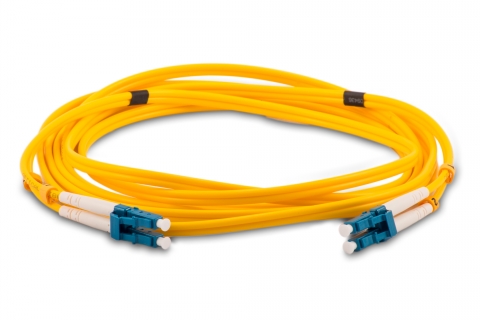Cables Blog
Why Choose Fiber for Your Business Connection?
Fiber optic cable is much faster than the fastest copper network cables.
Businesses that require fast access to data and the ability to both download and upload lots of data quickly will benefit from investing in fiber optic cable.
by Vikas Dayal • August 15, 2023
Fiber optic cable is much faster than the fastest copper network cables. Businesses that require fast access to data and the ability to both download and upload lots of data quickly benefit from fiber optic cable.
When fiber optic cable first appeared, it seemed like an expensive, highly exclusive kind of innovation that should be left to the huge telecoms and cloud services. Now, however, prices are on the decline, and businesses of all types and sizes should consider the significant business benefits of fiber internet connectivity.
Fiber Optic Cable Speeds
Fiber optic cable is much faster than the fastest copper. Businesses that require fast access to data benefit from fiber optic cable. You can expect your single mode fiber optic cable to transmit data at speeds between 1 Gbps and 10 Gbps depending on cable length, all traveling along a single strand of glass cable more fine than a strand of human hair.
Our OS2 Singlemode LC to LC Fiber Optic Cable is built with ceramic ferules ensuring optimal data transfer, and containing the highest quality Corning glass!

Greater Distance, Lower latency and Less Interference
Fiber optic cables can carry signals much farther than copper, with far less degradation in the signal strength. While copper cables can carry signals up to 328 feet without signal amplification, fiber option cables can send signals as far as 25 miles, depending on the wavelength the cable uses, and whether the cable is single or multi-mode. Organizations with multiple buildings spread across a campus, like research centers, hospitals, and some manufacturing facilities, can benefit from fiber optic cabling to carry signals between buildings.
Fiber optic cable is less prone to latency (or delay) issues than copper cable, which means that large files travel with less interruption. Streaming happens with little or no “buffering,” and remote collaboration is smoother.
Copper cables are subject to EMI, or electromagnetic interference, which can interrupt your signal. However, the pulses of light that bounce off the walls of the glass fiber as they travel along the cable are impervious to electrical interference from MRI machines in hospitals or microwaves in the break room. Our slim-diameter OM3 Fiber Optic Cables are even suitable for use in dense network switches in your server's data racks without any concern for an impaired signal.

Better Security
Bad actors can “tap” copper cables and breach your network security. Fiber optic cables can’t be tapped by physical intrusion. If they are cut, the signal disappears - no signal, no worry!
Reliability and Durability
Fiber optic cables are not susceptible to EMI because they use light to transmit data, not electricity. This means that a network supported by fiber optic cable will experience less downtime.
Fiber optic cable endures extreme environments better than copper cable, which is why it is typically used for undersea cabling. It isn’t as fragile as you might expect. Fiber optic cables will last longer, not just because they are more durable but because they have the capacity to handle increasing speeds and bandwidth for years to come without replacement.
Companies that conduct a lot of video conferencing, use HD video or other bandwidth-heavy applications like computer-assisted design, and who conduct large scale simulations or massive calculations benefit from fiber optic cable’s greater capacity and speed. In short, you can do more, and faster, with fiber optic cables. A great benefit of fiber optic is its ability to carry voice, data, and HD video signals simultaneously at greater speeds and with greater reliability than copper.
In the case of MultiMode Fiber Optic Cable, that means OM3 runs 10GB Ethernet to 300 meters, while running 40GB up to 100 Meters; and OM4 runs 10GB up to 550 meters, and can run 40GB up to 150 meters!
Versatility
Multi-mode fiber has greater bandwidth, but can’t achieve the distances that single mode can accommodate. That's why Telecom companies use single-mode cables to travel long distances. Within a data center or a workplace, however, multi-mode fiber optic cables offer greater bandwidth and speed locally. But no need to choose - network administrators and data center designers can mix multi-mode and single-mode fiber optic cables to get the most out of the benefits of fiber internet connectivity!
Questions?
If you're still unsure which fiber optic cable is the right choice for you, we're available to help! Contact Us, send us an email at sales@cables.com, or reach us by phone at 1-800-372-3725.
SHOP NOW:











